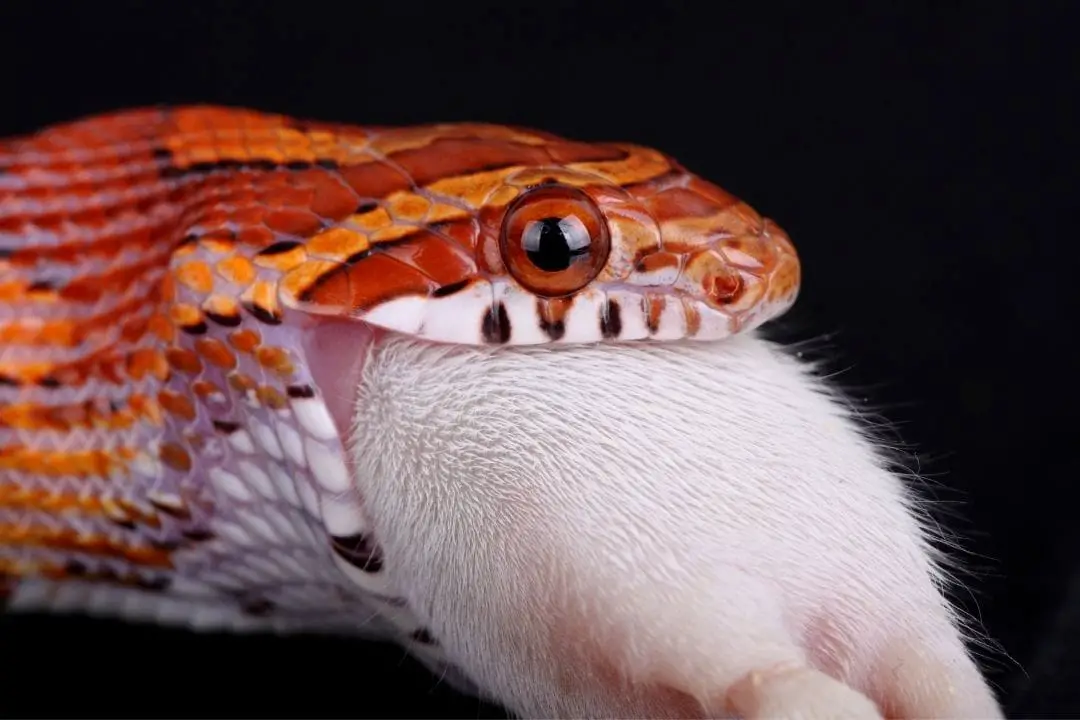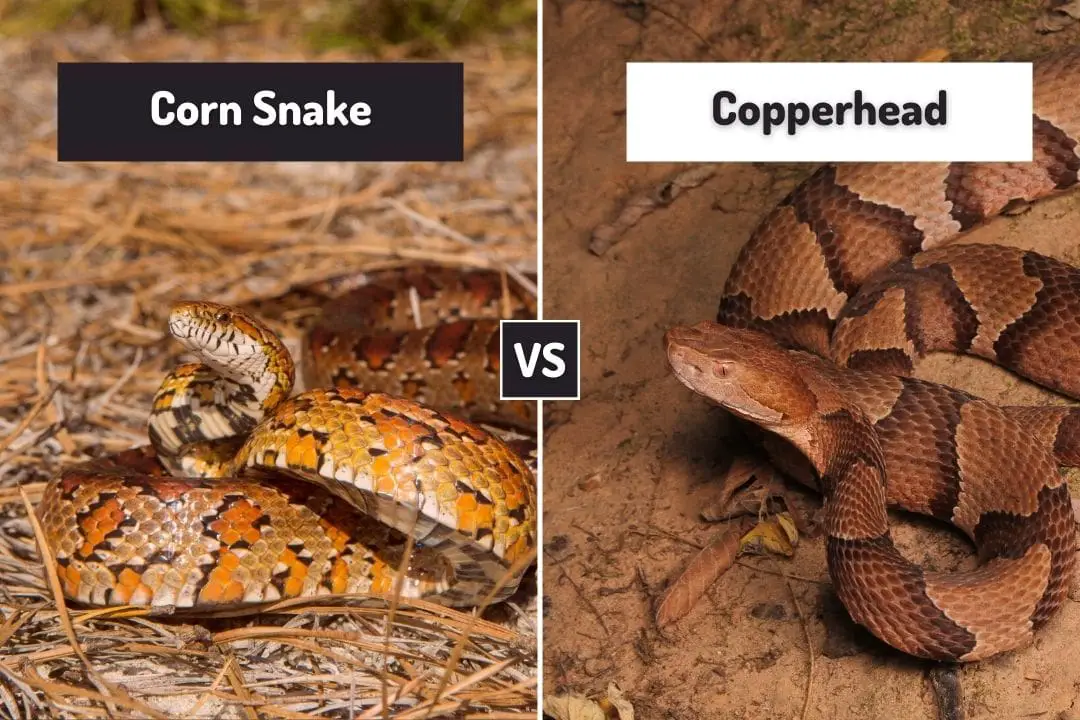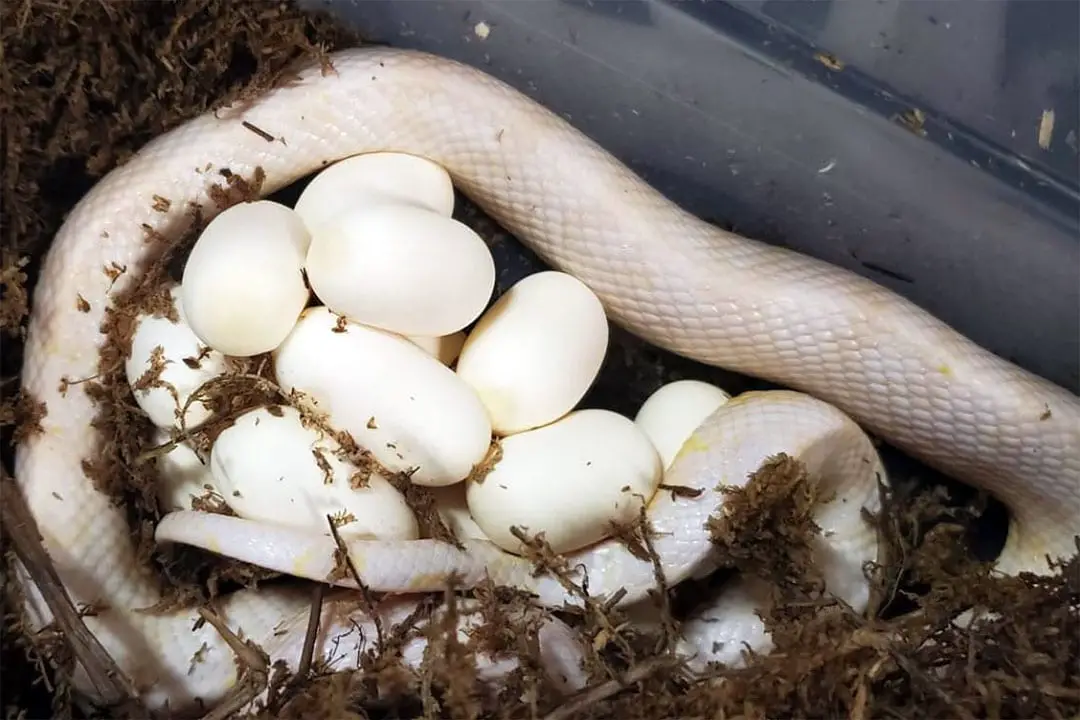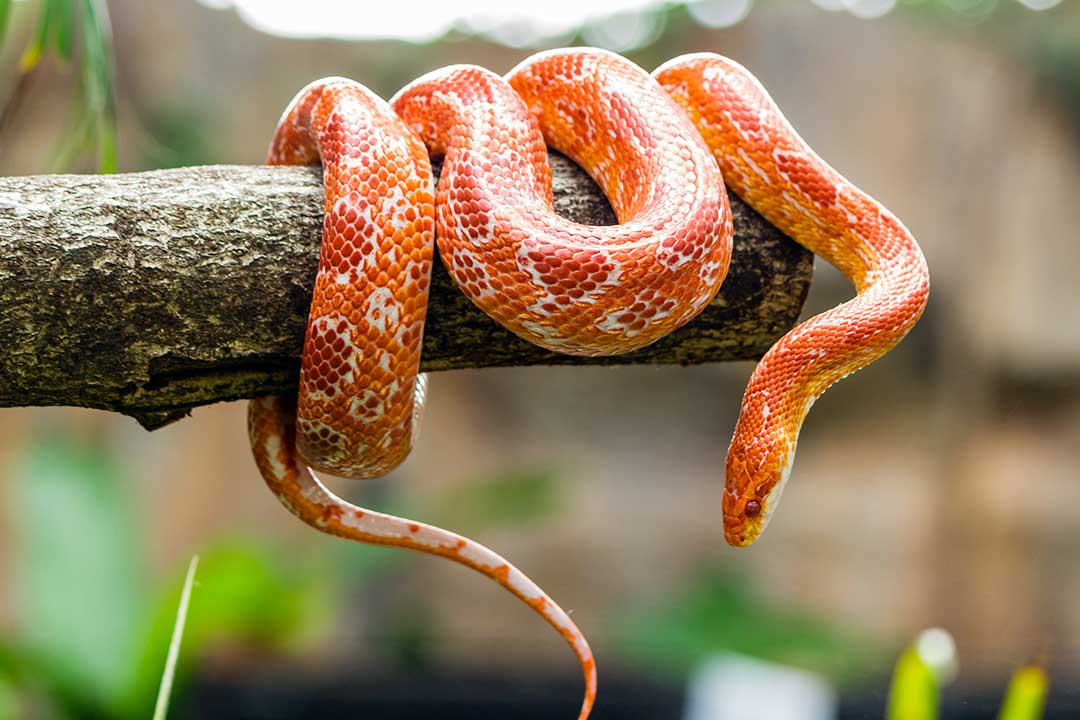If you are considering a corn snake for a pet, you need to know what they eat. As they are obligate carnivores, their diet is limited.
So, what do corn snakes eat?
A captive corn snake should be eating rodents as its main diet. It should be frozen and thawed for safety.
Diet in the Wild
In the wild, corn snakes have a fairly varied diet. An average adult typically preys on small rodents like mice and rats. They may also eat birds, eggs, frogs, and lizards.
This depends on what they find while hunting. Young corn snakes and hatchlings will typically eat mice, lizards, and frogs. The Smithsonian has a good fact sheet on corn snakes in the wild. Corn snakes are obligate carnivores, which means they can only eat meat.
Diet in Captivity
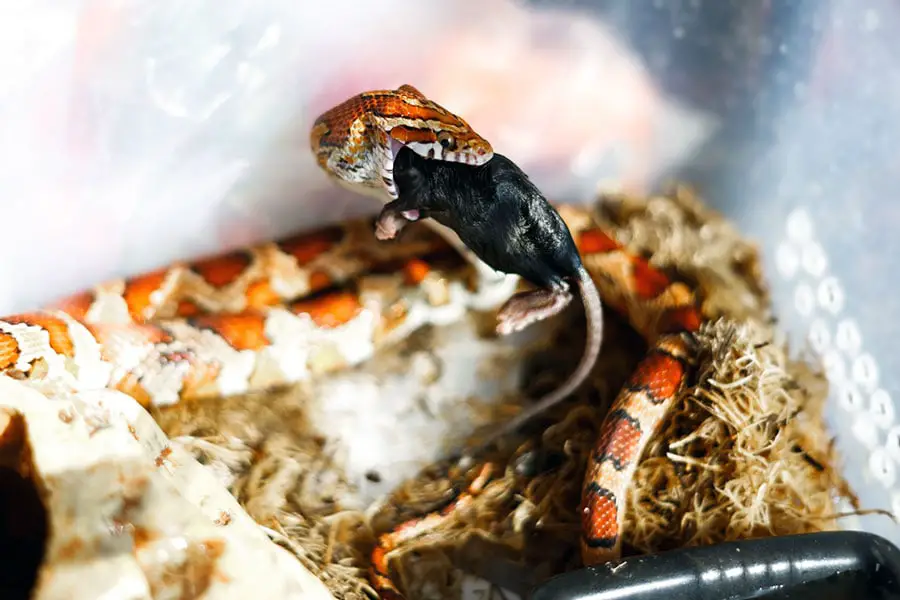
Everything you need to know about caring for Corn Snakes in captivity:
Read our Corn Snake Care Sheet (Complete 101 Guide)
In captivity, corn snakes are typically fed rodents. This is partly because mice are commonly bred for snake and reptile food. They are typically sold frozen.
You will thaw the rodent and then offer it to your snake as food. You can also offer eggs, or birds sold as reptile food to adult snakes. You should keep these as treats since a snake would not have this as a normal part of their diet in the wild.
For instance, lizards and frogs are common prey in the wild. They may appeal to hatchlings more, but they are more difficult to find than rodent feeders.
They also tend to be more pricey. Other common food items for reptiles like insects, fruit, vegetables, and fish shouldn’t be fed. Your snake likely won’t recognize them as food even if you tried. They also don’t give the nutrition your snake needs.
When to Feed
The prey you offer to your snake will depend on its age and size. This list assumes you are only feeding mice. If you have given your snake an appropriately sized rat, you should wait at least 5 days longer between feedings.
Wait until your snake is showing signs of hunting behavior before offering more food. Here is a simple chart from Wellsboro Veterinary Hospital to help give you an idea of what to feed and how often.
- Snake Weight: 4-15 grams Prey: Single Pinky Mouse Frequency: 4-5 days
- Snake Weight: 16-23 grams Prey: 2 Pinkies Frequency: 4-5 days
- Snake Weight: 24-30 grams Prey: Small Fuzzy Frequency: 5-6 days
- Snake Weight: 30-50 grams Prey: Regular Fuzzy Frequency: 5-6 days
- Snake Weight: 51-90 grams Prey: Hoppers Frequency: 5-6 days
- Snake Weight: 91-170 grams Size: Weaned Frequency: 7 days
- Snake Size: 171-400 grams Prey: Adult Frequency: 7-10+ days
- Snake Size: 400+ grams Prey: Jumbo Adults Frequency: 7-10+ days
You should make sure the prey is no more than 1.5x the width of your snake at its widest point. Sticking to close to the same width as your snake will reduce the risk of regurgitation.
This chart uses mice, but you could use rats for larger snakes. Make sure you weigh your snake regularly to monitor that they are growing well.
You want steady weight gain for hatchling or juvenile. Adults that are over 2 years old should maintain their weight.
Live, Dead, or Frozen Food?
The debate over what to feed your snake is a long one. Some insist that live prey is best to allow your snake to exhibit natural hunting behaviors. Others say that pre-killed prey is best.
The simple answer is that you should stick with frozen food if at all possible. It is more humane to your snake as well as the prey. It also reduces the risk of illness in your snake. Live mice or other prey can carry parasites that may transfer to your snake.
A live mouse can also fight back and injure your snake. Rats are well-known for being fierce when fighting for its life. For safety, live food should be a last resort. You also don’t need to worry about keeping a live mouse or rat in your home. If you are having trouble feeding your snake frozen, you could try pre-killed food. Look into proper methods for killing prey so that the prey animal doesn’t suffer or find a prey breeder local to you who can provide fresh prey.
Where to Buy Prey Items
When it comes to buying prey, there are a few things to keep in mind. You can use online sources for frozen prey, but having a few local sources is good in case of an emergency.
You need to find prey that is the proper size. The prey should have been fed properly and kept in good conditions during its life. This helps make sure the prey animal didn’t have malnutrition or illnesses that could make your snake ill.
Your local pet store may sell pre-killed food items. Reptile shops will normally carry prey as well. For online sources, there are a few options. I recommend Mice direct:
Micedirect Frozen Mice
- Direct from the producer
- Packed in dry ice, delivered by FedEx
- These feeder Mice for snakes are put to sleep with Co2 so they never suffer
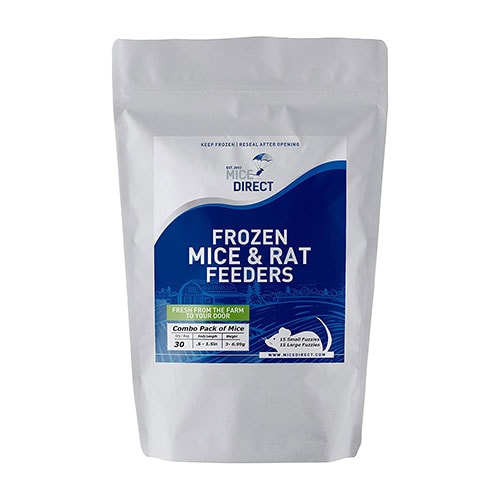
South Florida Rodents also offers a good amount of frozen mice. The pack sizes do mean that you may need to feed larger prey before you run out of mice.
You have a few more options with Layne Labs and Perfect Prey. You have more options for the amount of prey, which is good if you only have one snake. Large chains like Petsmart and Petco also sell frozen prey.
How to Feed Frozen Prey

Frozen prey items are very convenient. You can keep a stock of food for your snake, so you don’t need to go out and buy fresh prey for every feeding.
The biggest risk with frozen prey is thawing it improperly and making your snake ill. This is caused by the same factors that make meat for human consumption spoil. Follow proper thawing procedure and your snake should be happy to feed on what is offered. Here is how to thaw a whole mouse or rat.
First, place the prey in the fridge a day before you intend to feed. The day you want to feed your snake, put your prey into a BPA-free plastic bag and put it in warm water. You want to get the prey to body temperature. This can make for a stronger feeding response. Once it is warm, you can offer it to your snake. Using feeding tongs to move the mouse around can make your snake more willing to strike and eat the prey.
How to Help with a Reluctant Eater
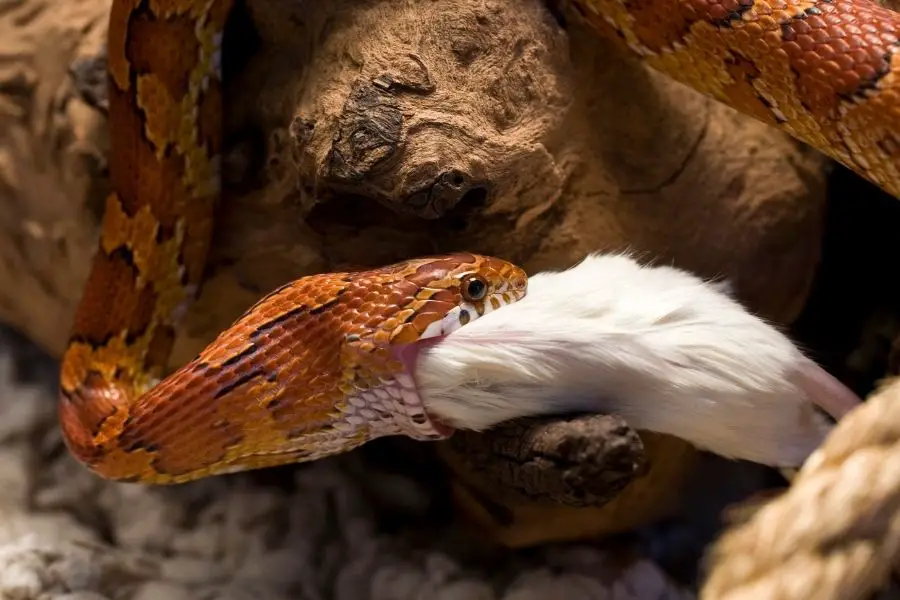
If your snake doesn’t want to eat, there are a few things you can do. First, make sure your snake is hungry. A hungry snake will be hunting around their enclosure for food. If your snake is about to shed or lay eggs, it will likely not want to eat.
Snakes that are ill will also not feed. If you notice your snake is interested in food, but not the prey you are offering, there are a few steps you can take.
The first is to make sure you properly thawed the prey and offered it while it was warm. Moving it around with feeding tongs can help make your snake think it is still alive and they will be more likely to strike and eat it.
If your corn snake is still reluctant, slicing the skin of the thawed prey can give a stronger scent that will make your snake more likely to feed.
Some snakes also don’t like light-colored prey, so they might take a prey item that looks more like a wild mouse.
Your snake may also take a freshly killed mouse. Live prey should be a last resort since there is a risk the mouse will fight back and hurt your snake or even kill it. You can also try offering bird chicks or eggs to adult snakes.
Many corn snakes love birds and will happily take a thawed bird even if they won’t take a mouse. Just make sure it is meant to be fed to snakes. Snakes need whole prey to be healthy.
You also should switch back to rodents as soon as possible. You can also look into frozen lizards or frogs as prey. They can be more expensive though and harder to locate.
In Summary
Your snake should be fed on frozen and thawed rodents ideally. You should make sure they are the right size for your snake, and that you don’t over or underfeed. If you have any thoughts on feeding corn snakes, be sure to leave them below.
